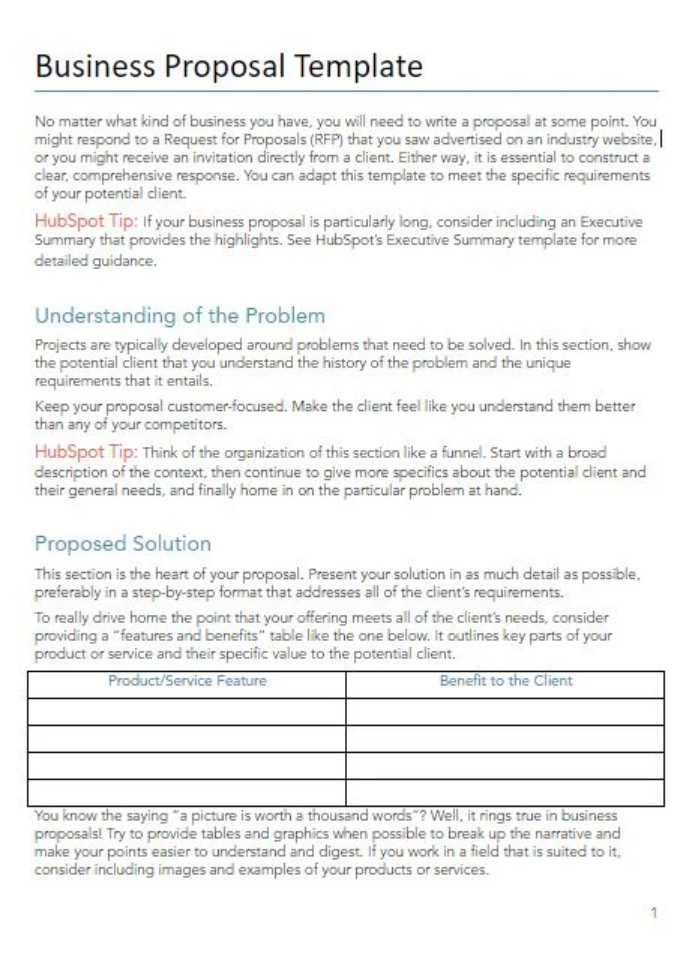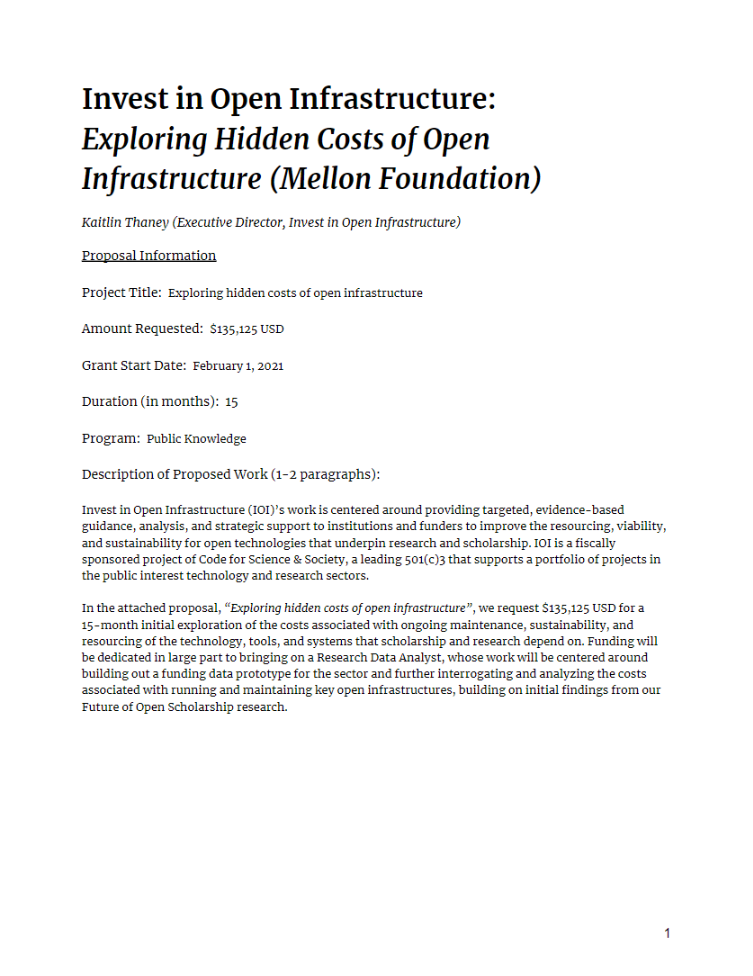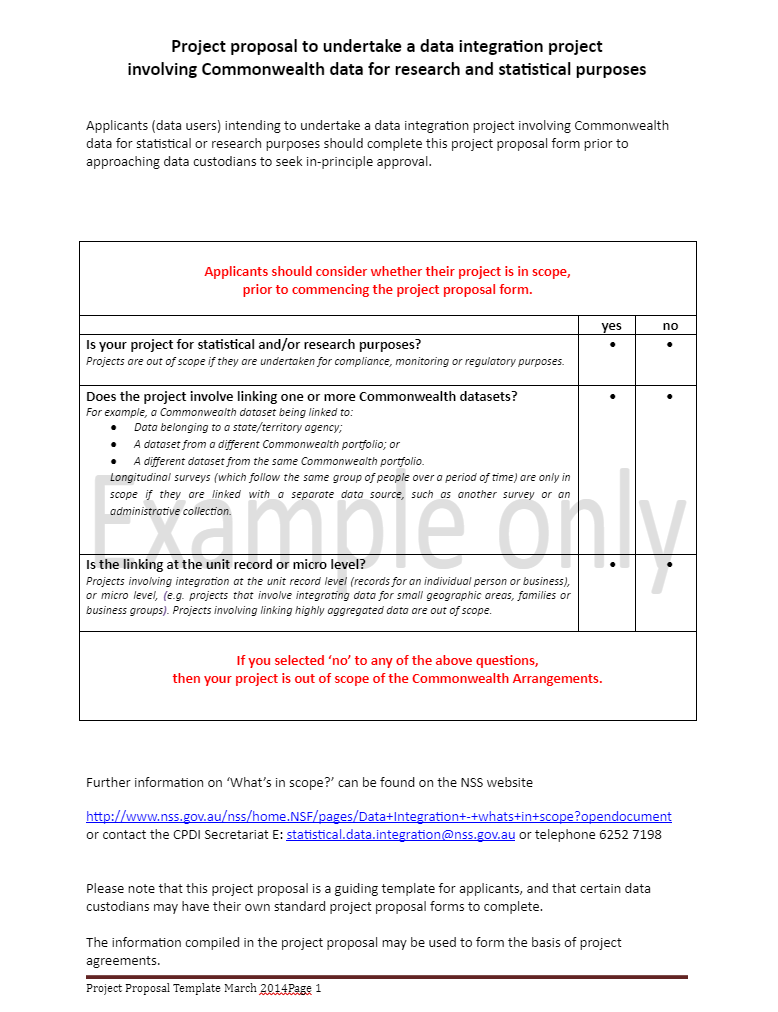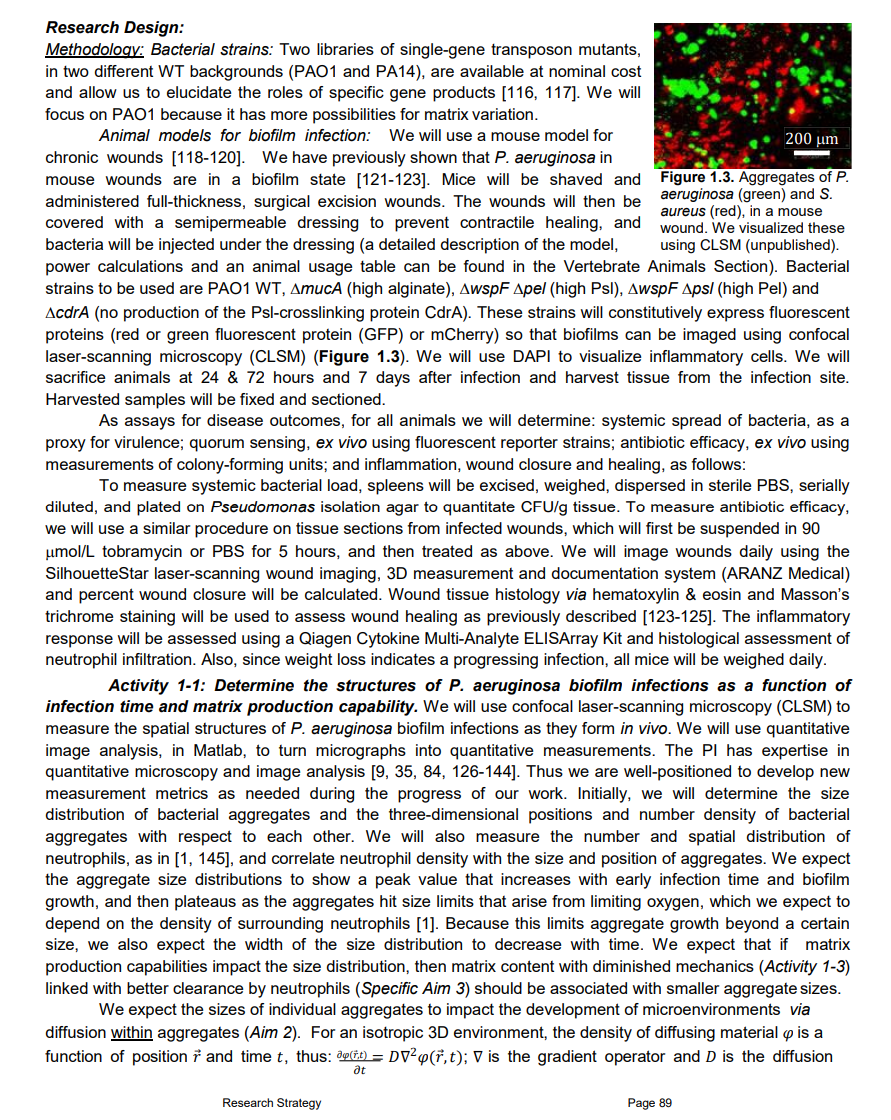Proposal writing is more than just putting words on paper—it demands a deep understanding of your audience. In fact, many organizations invest in professional proposal writers for high-stakes projects because they know how crucial it is to get it right.
So how do you do just that? Let’s go through four real-world examples of successful proposals, highlighting key takeaways:
- A business proposal template from Hubspot
- An accepted research proposal submitted to the NIAID
- A winning grant proposal securing $135,125 USD for a 15-month project
- An accepted project bid for a proposal to the NSS Australian Government
Ready to make an impact without all the guesswork? Skip the learning curve and request 10 free, ready-to-send business proposals, crafted by our expert writers with your unique details.

So what makes a good proposal?
Because there are various kinds, it’s difficult to provide a one-size-fits-all recommendation.
There are, however, some general writing principles that define great proposal writing:
- Good proposals are mindful of the format. And not just for formality reasons. Grant and research proposals usually have specifications around formatting, length of proposal, as well as the topics to be covered. Not following instructions is common grounds for rejection.
- Good proposals demonstrate competence, instead of talking about it. Readers are looking for cold, hard proof that you’ve done the work. For freelance proposals, this means including portfolio samples and case studies for a history of successful projects. For funding and grant proposals, this means writing out a detailed financial plan to show investors that their money is safe with you.
- Good proposals meet readers where they are. More detail ≠ better proposals. Even the best sales coaches say that the best proposals are a mix of data and narrative. Don’t get lost in the numbers–frame them in the context of impact and purpose to drive urgency.
- Good proposals speak directly to the audience. Tailoring proposals is so much more than just writing the “right things”. A big part of it is knowing what your audience cares about. For instance, if you’re pitching to a funding body, your core message should be about similar alignment in organization values, whereas a sales proposal should focus on cost-benefit analyses to communicate the product or service’s value.
Proposal examples, and what you can learn from them
Now that you have a general idea of what makes a good proposal, let’s walk through some specific examples.
Business Proposal Example
Hubspot’s business proposal template
Finding an actual business proposal is difficult–presumably because a lot of them are under NDAs and privacy clauses. Luckily, Hubspot has a free downloadable template that can help you understand how to approach each section.
Looking for more free business proposal templates? Choose over 1,000+ free, editable construction bids, project proposals, budget proposals, freelancer and agency proposals. Get access to interactive elements like video embeds, eSignatures, and analytics tracking.

This proposal includes:
- Summary of the problem
- Proposed solution, in table format
- Pricing information
- Milestone timetable
- Conclusion
- Terms and conditions
- Appendices
What this proposal can teach you:
- How to identify a customer-focused, empathetic problem statement. Hubspot’s template starts with the “Understanding of the problem section”. They advise business proposal writers to think of this section as the beginning of the funnel. Basically, you want to start with the description of the problem’s context and start narrowing down to the specific problem you want to address.
- How to frame solutions into tangible, benefits-oriented statements. The table format is great for demonstrating the actual benefits of proposed solutions with a clear 1-to-1 representation.
- How to reflect changing variables in the pricing section. For pricing structures that depend on changing variables (E.G. number of meetings per month, project start and end date) Hubspot says it’s best to illustrate how these changes will affect the pricing down the line to make sure all stakeholders are onboard.
Quick tip: If you want to a solid headstart, proposal software such as Proposally.ai has quick-launch, free, editable templates you can use. You can mix and match different sections and use custom variables and our Brand Kit feature to instantly customize any template with your specific details and branding.
Research Proposal Example
Assessing the roles of biofilm structure and mechanics in pathogenic, persistent infections
This approved health sciences research proposal was submitted by researchers from the University of California San Francisco to the National Institute of Allergy and Infectious Diseases.
The proposal features a comprehensive budget table that allows stakeholders to easily see how funds will be allocated. With proposal software like Proposally.ai, you can effortlessly drag and drop tables and charts, giving stakeholders a clear and complete view of the financial projections.
This proposal includes:
- Project summary
- Project narrative
- List of facilities and equipment
- Profile of key persons/researchers
- Budget table
- Comprehensive research plan
What this proposal can teach you:
- How to outline research objectives by structuring it in terms of the rationale, approach, result interpretation, and potential issues. This structure places their proposal within a broader context of the field. It’s a great way to communicate that you have alternative plans if the initial approach fails.
- How to write compliant, ethical research activities, even ones involving animal testing or human subjects. Because the research proposal involves animal testing, they added ethical considerations to convince research bodies that they’ll be conducting experimentation in the conduct of scientifically sound research.
- How to communicate the importance of the proposal, within the broader context of the field being studied. The proposal doesn’t just talk about the significance of the project–they focus on communicating how the research can address the gap that has been existing in the field. They demonstrate the importance of the project by calling back to “frustrations” from the community and similar organizations to underscore the significance of the project.
Grant Proposal Example
Exploring Hidden Costs of Open Infrastructure
Similarly, this next one is an example of an approved grant proposal. This grant request was submitted by Invest in Open Infrastructure to the Mellon Foundation. The organizers requested $135,125 USD for a 15-month project.
If you’re gearing up for a big ask, this proposal demonstrates how to frame your grant request in the context of the community and the area/field of study. It’s a great reference for showing investors or funding bodies that you’re truly embedded in the field of study or community that you’re serving.

This proposal includes:
- Title page
- Proposal narrative
- Proposed activities and rationale
- Problem statement
- Previous and related work
- What needs to be done
- What we need to accomplish these tasks
- Budget
- Expected outcome
- Diversity, anti-discriminatory, and inclusion clauses
- Addressing risks E.G. change in leadership
What this proposal can teach you:
- How to communicate the importance of the proposal, within the broader context of the field being studied. The proposal doesn’t just talk about the significance of the project–they focus on communicating how the research can address the gap that has been existing in the field. They demonstrate the importance of the project by calling back to “frustrations” from the community and similar organizations to underscore the significance of the project.
- How to justify costing by describing jobs-to-be-done for the grant. The “What needs to be done” section” is incredibly detailed when it comes to itemizing the different phases of the project. More importantly, the proposal writer addresses where their budgeting estimates might be coming from, pointing to specific peer-reviewed sources to demonstrate fiscal responsibility.
- How to demonstrate the grant requester’s credibility and impact within the community or field of study. Throughout the proposal, the writers illustrate how the organization is embedded in the community by referring to studies and projects that it both impacts and is impacted by. There is also a dedicated section that outlines a process of how they’ll be sharing findings and insights through workshops, community calls, and blogs.

Quick tip: Consider embedding a video and adding photos of your organization to really show your commitment to the community. Elements like tooltips give stakeholders the option to access extra information like primers, case studies, or reports without cluttering the proposal body.
Project Proposal Example
Data integration project involving Commonwealth data for research and statistical purposes
The National Statistical Service of the Australian Government put out a request for proposal (RFP) for a data integration project. Here’s the template applicants used to apply for the project.
You can use this to get an understanding of what clients are looking for in a project proposal, specifically ones where there are multiple contractors or bidders for the same project.

This proposal includes:
- Biography of the researchers
- Project summary (objectives, deliverables, data required, projected completion date)
- Datasets and data custodians
- Legislations that apply to the project
What this proposal can teach you:
- Which sections to include when bidding for high-profile projects with multiple other applicants. This template was created by the NSS branch of the Australian Government and used as the official application template. It shows exactly what clients (in this case the NSS) are looking for when evaluating a project proposal.
- How to justify privileged access to important data such as government statistics or company documentation. The template includes a section on data access, where applicants are requested to justify how they’ll be using the data for the project. It’s a great practice for de-risking your proposal and showing your diligence to the reviewers.
What is a proposal?
A proposal is a structured document or presentation that outlines a plan, project, or initiative, written specifically to request the support or approval of its target audience.
Even though there are general approaches, the writing technique may vary depending on the kind of proposal you’re writing.
In this article, we’ll be exploring an example or template for each of the following:
- Research Proposal: A document used for planning a research project; this usually includes its goals, methods, and why it matters.
- Grant Proposal: A request used for getting funding; this usually includes the project’s purpose, what it aims to achieve, and how the money will be spent.
- Business Proposal: A document used for offering a product or service to a potential client or partner; this usually includes the benefits, terms, and conditions.
- Project Proposal: A plan used for detailing a project’s scope and how it will be done; this usually includes the goals, timeline, and needed resources.
How can examples help me write better proposals?
As I’ve mentioned, proposal writing skill usually comes with familiarity with the target audience and repeated practice.
But as with any other writing skill, mimicking existing examples and going through what makes them so successful is usually a great boost, especially if you don’t have a lot of time or opportunity to practice.
Sure, these examples might not include the specific details you need to cover in your proposal, but looking at the best ones can reveal things like:
- Structure: what layout is best/common for this proposal?
- Content: what’s the industry-standard way of writing individual sections?
- Best practices: what is it about this specific proposal that made it stand out from others? Why did it get accepted?
At the end of the day, understanding those things is what makes great proposal writing.
3 proposal writing techniques to close more deals
Use their own language
I made an earlier point about tailoring your proposal. So how do you actually do that?
Using your reader’s language is as simple as copying or repeating back phrases your readers use in their own touchpoints. If you’re writing a grant proposal, look at the funder’s website, specifically their mission vision statement.
For example, the MacArthur Foundation emphasizes diversity, equity, and inclusion as being part of their core values.
A good proposal writer would specifically highlight qualities or previous projects that demonstrate alignment. You can talk about a grassroots approach to community-building to show how embedded you are to the cause.
On the other hand, if you’re writing a business proposal for a client, paying attention to things they mention during the discovery phase should help you get a feel of their “language”.
In this case, you want to pay attention to the words they use to describe their problem statements.
Do they emphasize delays in production? Do they repeat being worried about falling off the market to new competitors? Use those in your problem statement to make them feel like you really know what it’s like to be in their shoes.
Be specific with detail
Add in reports to give your stakeholders the most context. Proposally automatically generates charts, bars, and graphs based on your CSV and XLSX imports.
You can also add interactive elements like QR codes and labels to redirect prospects to relevant material, without cluttering up your proposal.

Add e-signatures and text fields
Cut down on the back-and-forth by including interactive elements like short and long text fields in your proposal. This allows prospects to fill in their information right away, so you can move forward with the next steps more quickly.
Adding an e-signature option can also make a big difference. It lets you close deals on the spot, and using e-signatures can increase your conversion rates by up to 20%.

In a nutshell
Becoming skilled at proposal writing can really improve your chances of getting your projects approved and funded.
By looking at successful examples and following best practices, you can write proposals that effectively communicate your ideas and meet what your audience is looking for.
Whether it’s a grant, business, or any other type of proposal, it’s all about understanding the key elements and tailoring your message to your readers.
Remember, your goal is to show that you know what you’re doing, address your audience’s concerns, and present your project in an organized and engaging way. Take the insights and examples provided here to refine your proposals, making them both well-written and persuasive.


